Here you will find the best and the closest version of the true Neapolitan Pizza Recipe for homemade pizza bakers.
The Neapolitan Pizza is the style of pizza that started it all and made the whole world fall in love with pizza.
At Homemade Pizza Pro, we take a modern approach to pizza making but with a sense of tradition. We studied and reinvented the recipes created by pizzaiolos in Italy, who dedicated their lives to perfecting pizza, and adapted them to a homemade version.
Why go through all the trouble? When at home, you can pick up the phone order pizza from your closest place, and be done.
Because we care! We care for our friends and family. We care about what we eat; and because we live. Pizza is meant to be shared; it fosters conversation. There is no better feeling than sharing what you’ve made with others.
We strongly believe that you can make an excellent pizza in your kitchen.

Do You Need a Pizza Oven?
It is best if you have a pizza oven because your kitchen oven won’t reach the necessary temperature. However, even if you lack the specialty oven that cooks your pizza in mere minutes, at blasting temperatures of about 900°F, you can still end up with beautiful results using the oven in your kitchen.
There are several different types of pizza recipes out there. But here, we are going to do something different. Why?
Because this is not about us; this is about YOU. We want you to learn the techniques and tricks to make pizza at home.
We’ll give you a starting point and suggestions on how to make pizza, but it’s about you actually learning the nuts and bolts of making pizza in your own kitchen. We encourage you to take the challenge and become the best homemade pizza baker!
So, let’s get started.
Temperature & Baking Time
Note that our recipes are shown for a normal kitchen oven that reaches temperatures up to 500°F degrees.
For best results, pizzas should be baked in ovens that reach from 800°F to 950°F degrees. If you are using a wood-fired oven at a higher temperature, the bake time should be reduced by 5 to 7 minutes.
NEAPOLITAN PIZZA RECIPE
Recipe Details
Our Homemade Neapolitan Pizza Recipe is a base recipe that can be easily adapted to any other pizza style. It has only flour, yeast, water, and salt.
It only takes 20 minutes of hands-on time. Just give a day of fermentation for its great flavor, and you are done. That’s it!
ABOUT THE INGREDIENTS
Flour
An authentic Neapolitan pizza must be made with Italian 00 Flour (double zero or type 00). Double zero is a designation that indicates the fineness of the grind, on a scale going from 2 (coarse) to 00 (finest). Double zero flour is milled from soft wheat, which has less elastic gluten than hard wheat.
The result is a tender dough that requires a light touch when you’re working with it. If you can’t find King Arthur bread flour, look for another bread flour that has about 12.7% protein.
Yeast
Authentic Neapolitan pizza is made with fresh yeast that is combined with flour and water to make a starter or preferment. The starter is mixed with the rest of the flour and the remainder of the water to make the dough.
Fresh yeast is not only challenging to find these days, but it is also perishable. It doesn’t last long. So, for home use is not recommendable.
In our recipe, we use active dry yeast. It is not necessarily faster, but it gives a sense of security. Italian 00 Flour is relatively expensive compared to all-purpose flour. So, you don’t want to waste a single bit of it.
When using active dry yeast, you activate the yeast first, then combine it with the rest of the ingredients. By doing this, you make sure your yeast is alive.
If you were to use instant, which you can. You mix the flour, the yeast, and water and let sit. If the dough doesn’t rise, the yeast is dead, and you must discard all your flour and start again.
Water
You can certainly use tap water to make your pizza dough if that water is good to drink.
Bottled water will perform better, just try to avoid mineral water, as it’s not recommended for pizza dough.
Salt
Fine Sea Salt will taste and dissolve better than table salt. You can still use table salt, but keep in mind that it can change the taste of your crust as regular table salt as an iodine taste.
EQUIPMENT
- Stand Mixer
- Digital Scale
- Mixing Bowls
- Bench Scraper
- Round Dough Scraper
- Proofing Box
- Two Baking Stones or Baking Steels
INGREDIENTS
Dough
- 500g 00 Type Flour or Bread Flour
- 325g Water
- 5g Active Dry Yeast
- 10g Fine Sea Salt
Sauce
- 120 ml Tomato Sauce
Toppings
- 300g Low-Moisture Mozzarella Cheese
- Extra Virgin Olive Oil for Garnishing
- 300g Low-Moisture Mozzarella Cheese
- Additional toppings of your preference
Set all the ingredients in front of your work area. This is what the French call “Mise en Place” or everything in its place.
Everything you need in place will save you time as you don’t have to ramble looking for things that you need.
Neapolitan Pizza Recipe
DIRECTIONS:
Prepare the dough
ACTIVATE YEAST
- Separate 20 grams of water from the total water and heat it up to 95° – 105°F.
- Mix the lukewarm 20 grams of water with the yeast together and whisk them in a small bowl and let it sit for 10 to 15 minutes.
When the activation period is over, the mixture should be bubbly. If not, the yeast is dead, discard the mixture, and start again with new yeast. If you are using Instant Yeast, you don’t need to activate the yeast. Mix the flour directly in with the yeast.
MIX THE DOUGH
- Attach the dough hook to the electric mixer.
- In the bowl of the electric mixer, mix the flour with the yeast mixture, and the remainder of the water and mix on low speed until the dough comes together, about 1 minute. The dough will be stiff while mixing.
- Add the salt to the mixture and mix for 1 minute.
KNEAD THE DOUGH
- Knead the dough in the mixer on low speed for 5 – 7 minutes.
- Switch to medium-low speed and mix for another 2- 3 minutes. Total kneading time should be from 7 to 10 minutes. The dough should come together into a big ball of dough attached to the dough hook.
- Detach the mixture from the dough hook and the walls of the mixing bowl and form one big mass of dough. You can leave it in the same mixing bowl.
FIRST FERMENTATION
- Cover tightly and let the dough ferment in the refrigerator until it proofs and almost doubles in size, for about 1 to 1 ½ hrs. The ideal temperature for the first fermentation is 80°F. Some ovens have a “Proofing Setting” you can use.
You can also let the dough ferment for up to 24 hours in the refrigerator for more flavor.
At the end of this first fermentation, you will have a big inflated doughball, like a balloon.
DEGAS THE DOUGH
- With your fist, push down on the mixture and deflate it. *This will release all the accumulated gas from the dough.
- Once you flatten the dough, bring it together into a big ball again.
SHAPE INTO DOUGH BALLS
- Divide the dough into 3 equal pieces with a bench scraper, about 280 grams each.
- Make a tight ball out of each piece of dough and make the smooth side the top, tucking the rough bottom side into itself to swell up the top.
- Firmly squeeze the balls near the bottom to get out any air pockets.
- Gently roll the bottom under your palm on a dry work surface, using a circular motion to close the bottom and smooth it out. The finished balls should be tight and smooth all over.
SECOND FERMENTATION
- Place the dough balls evenly in a proofing box or on a wide tray, making sure they are separated and not touching.
- Cover tightly and refrigerate for 8 to 24 hrs. After the balls have rested, use them immediately or chill them for up to 36 hrs.
- Remove the balls from the refrigerator and let them sit for about 1 hr. to take the chill out. This will make the dough balls easier to shape.
PRE-HEAT THE OVEN
- Place two baking stones or steels in the oven racks with a 6 to 8-inch separation from each other. If you only have 1 stone/steel place it in the middle rack of your oven.
- Set the oven to 500°F and pre-heat for about 1 hr.
- Prepare the toppings for the pizza and have everything in its place.
SHAPING OF THE DOUGH
The pizza must be stretched out by hand so there’s not too much stress on the gluten and to distribute the carbon dioxide of the dough, from the center towards the outside to create the border.
Here is a quick guide on how to shape pizza dough. When shaping dough always keep in mind the size of your oven and the size of your stone. If you have a 14-inch stone or steel, you should shape your crust to about 12-13 inches leaving a little space to work with.
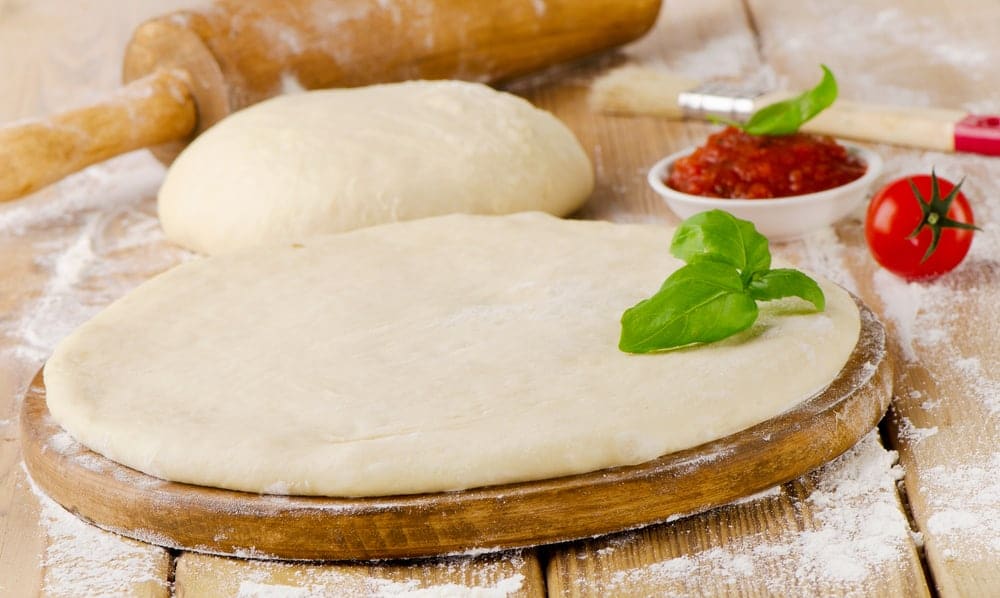
How to Shape Pizza Dough
Step 1: Prep your Area
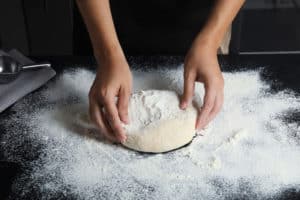
Dip the dough into a little flour, shaking off the excess, and set it on a clean, lightly floured surface
Step 2: Flatten the Dough
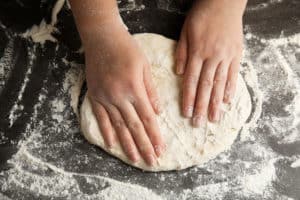
Start stretching out the dough with your hands, turning the ball as you press down the center.
Step 3: Create the Rim
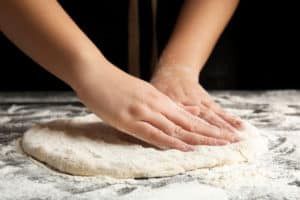
Using your fingertips, dimple the dough a few times. Create the rim of about 3/4 inch.
Step 4: Work the Dough
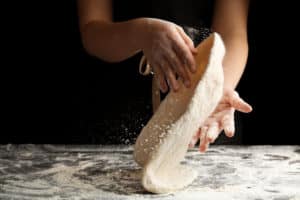
Lift the dough from the surface and bring it from one hand to the other. Its own weight will help stretch it
Step 5: Stretch the Dough

Take it up in your hands, turning it with your fists, gently pulling with each rotation to stretch out the dough.
Step 6: Shape the Dough
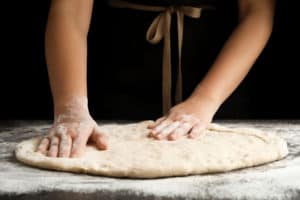
Pulling from the center outstretch the dough until you form a perfect circle.
LAYING OF THE PIZZA
- The laying of the pizza is one of those details that make the difference between a successful pizza and a lousy pizza. To make the best pizza, it’s better if you dust a wooden pizza peel with flour and slide it under the dough.
- For the laying of the pizza to the pizza peel, we always use regular flour since the only purpose is for the pizza not to stick to the peel. In addition to the flour, you can also add about a teaspoon of course cornmeal. The grains of the cornmeal serve as tiny wheels in between the dough and the peel, making it quite easy to transfer to the oven. If you are making any other pizza style other than Neapolitan or NY Style, the laying of the pizza will be much simpler as you will lay the dough either in a sheet pan or a cast-iron pan. The dough will remain in the pan during the baking process and does not need to be transferred to the pizza stone or steel.
- During the laying, you should pay attention to the following:
- Leave a little bit of board to the edge of the dough
- Give the right thickness to the pizza
- Give the right shape
- Be careful not to make holes
If you do have some holes, don’t worry, it’s okay if a hole or two forms. You can patch them by gently pulling some of the surrounding dough over to close and seal the tears.
Alternatively, if your find stretching by hand is difficult, use a rolling pin to work the dough until you form a 12-inch circle.
TOP THE DOUGH
- Don’t forget that all the ingredients and all the toppings shall be prepared beforehand. You should not attempt to make a pizza without having everything on hand.
- When topping your pizza, start with the sauce, then add cheese and the other topping ingredients. Note that you must work quickly, so your dough doesn’t get too soft or sticky as it sits on the pizza peel under the weight of the toppings.
- The first thing to keep in mind is not to overdo the seasonings and the toppings. Top your pizza with your favorite ingredients. Pizza toppings have a lot to do with personal taste. Balancing the quality and quantity of ingredients is the rule to follow to prepare a good pizza. To top the pizza check the below how-to.
How to top your pizza dough
So to get started, have all the ingredients ready, the sauce, the cheese, and any other toppings you may want to add.
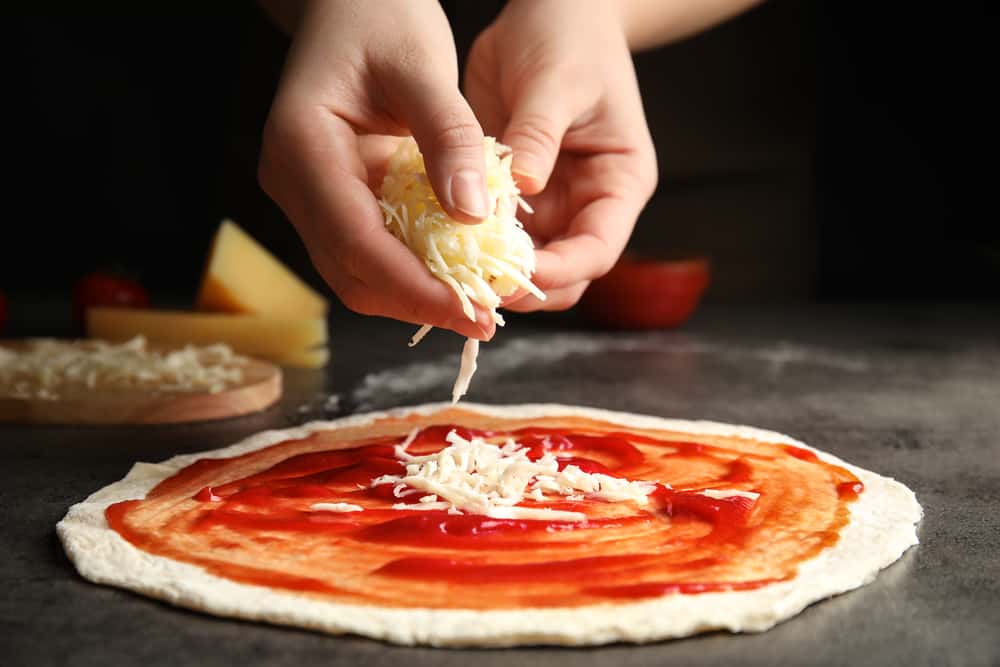
Steps to Top your dough:
Step 1: Spread the Sauce
Grab a large, preferably flat spoon and disperse the sauce onto the center of the dough. Use the back of the spoon to spread the sauce outward from the center in a spiral motion. Leave about ¾” inch around the rim of the pizza. Shake the pizza peel to make sure the dough isn’t sticking.

Step 2: Spread the Cheese
Pour the cheese onto the center of the pizza and spread it with your fingers. Do not go all the way up the rim.
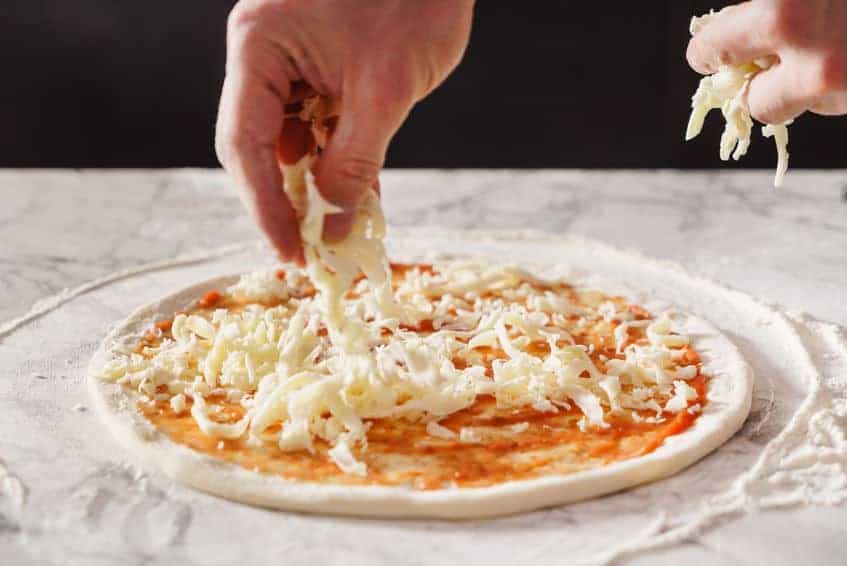
Step 3: Add your favorite ingredients
Arrange the rest of your toppings evenly over the cheese.
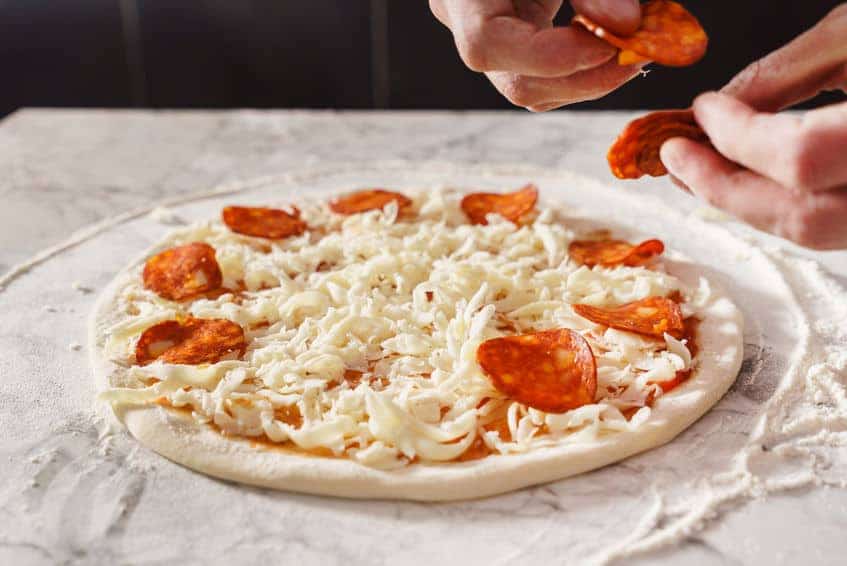
Step 4: Final Shaping
Give it a final shape by adjusting the rim as necessary to give the pizza a perfectly round shape.
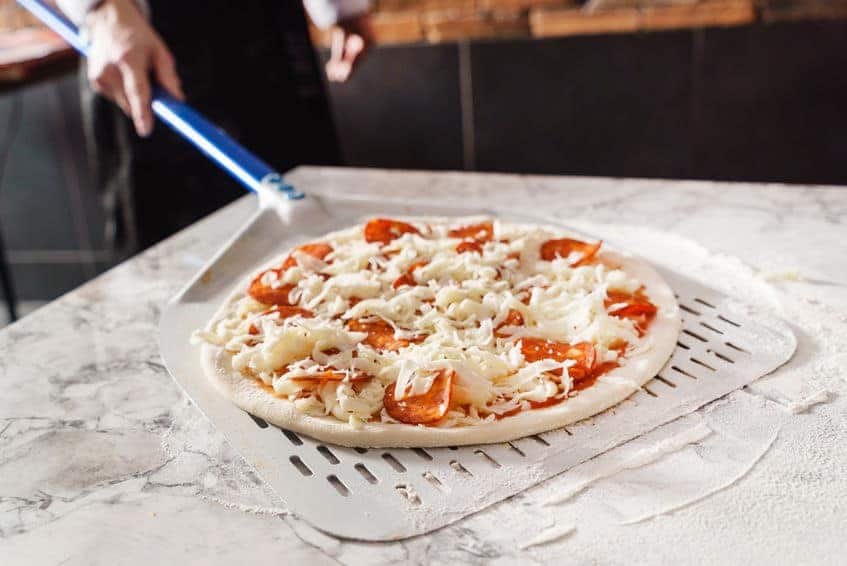
TRANSFER THE PIZZA TO THE OVEN
Here is the tricky part of making pizza at home. However, if you follow these steps, you have a better chance of getting extraordinary results.
Adding coarse cornmeal to the wooden peel helps the pizza slide off to the stone.
After topping your pizza, shake the pizza back and forth again to make sure it isn’t sticking. If it sticks to the peel, lift the edge and add flour, cornmeal, or a mixture of both.
Slide the prepared pizza onto the hot pizza steel, stone, or baking sheet. The pizza peel and the stone or steel should be at the same level, not angled or sloped.
Bring the pizza to where you want to place it just slide it off the peel by moving the peel forward and backward. Once the dough touches the stone or steel, it will stick to it.
Look at the shape; you will only have a few seconds to make any adjustments with the peel. You must be incredibly careful as it would be scorching to touch with your bare hands.
We think this is the hardest part of making pizza at home. It takes some practice to get it right. So, don’t be disappointed if you can’t get it done the first time.
We recommend using a wood peel to transfer the pizza to the oven. The dough slides faster with the wood peel. Then, switch to a steel peel to rotate the pizza and to remove it from the oven when done.
BAKE THE PIZZA
Unfortunately, we can’t give you an exact period of time to bake any pizza. Every oven is different, so review once again our section on “Get to know your oven” to check what works best for you.
We can definitely tell you that you should do the following:
Set a timer for at least 5 to 6 minutes so you can check the progress. If you see any large bubbles in the pizza, just poke them with a knife and add additional cheese on top of that section.
Try not to open the oven door too much as every time you open that door, the oven will lose temperature, and your pizza might turn mushy, and it will take longer to cook.
Grab the peel and rotate the pizza 180° if you feel the back is cooking faster.
Check the bottom of the pizza to make sure it has been cooked well. It should be rich brown and burnished. The total cooking time should be from 12 to 15 minutes total depending on your oven.
Bake until the crust is properly browned. Check your time, so see how long it took to cook and keep a record of it.

FINISH
It’s time for the best part. After you waited a day or two to make your pizza it’s now time to taste the fruits of your labor.
With the pizza peel, transfer the pizza to a cutting board. Do not cut the pie on your peel, or you may damage it.
Hold on; we are not done yet.
You may want to add a small number of your finishes right before serving your pizza. If you like, drizzle the pizza with garlic oil, or add flaky salt, our favorite truffle salt, or any other add-on that you may want.
Just like any other food, we eat first with our eyes, you need to make it’s pretty and pleasant to the eye. Garnish with your favorite garnishes. A pop of color is always nice, as well as a touch of texture.
You can garnish your pizza with Oregano, Basil, Arugula, Parsley, or any other herb you deem appropriate.
The Last Slice
You’ve made it to the end! Now that you’ve learned how to make your pizza with this Neapolitan Pizza Recipe.
- The next step is quality control. Here is what you should expect from it.
- When you grab your slice, it should support its ingredients; the pizza shouldn’t bow to you.
- You should be able to fold it without breaking it.
- The top crust should be uniformly browned.
- The bottom crust should also be browned with no burned spots.
- The inside of the crust should be bready with beautiful even holes.
- The cheese should be stringy, perfectly melted, and golden brown.
- With the pizza peel, transfer the pizza to a cutting board. Do not cut the pie on your peel, or you may damage it.
- You may want to add a small number of your finishes right before serving your pizza. If you like, drizzle the pizza with garlic oil, or add flaky salt.
- For additional flavor, add a sprinkle of Parmesan or Pecorino to give it an extra pungent flavor.
- Garnish with your favorite garnishes. A pop of color is always nice, as well as a touch of texture.
- Cut the pizza into slices.
- Serve immediately.
- Enjoy with friends and family!
We hope this recipe guide serves you at least a starting point on how to make pizza at home. If you like it, please share it with your friends and family or anyone interested in making the best Homemade Pizza.
Get your Recipe Card
Print and save your favorite recipe.
Neapolitan Pizza
Equipment
Ingredients
Dough
- 500 g 00 Type Flour You can also use Bread Flour
- 325 g Water
- 10 g Fine Salt
- 5 g Dry Active Yeast
Sauce
- 120 ml Tomato Sauce
Toppings
- 300 g Low-Moisture Mozzarella Cheese
- Additional toppings of your preference
- Olive Oil for Garnishing
Instructions
Prepare the Dough
- Activate Yeat – Separate 20 grams of water from the total water and heat it up to 95°F –105°F.
- Mix the lukewarm water with the yeast together and whisk them in a small bowl and let it sit for10 to 15 minutes.
Mix the Dough
- In the bowl of the electric mixer, mix the flour with the yeast mixture, and the remainder of the water and mix on low speed until the dough comes together, about 1 minute.
- Add the salt to the mixture and mix for 1minute.
Knead the Dough
- Knead the dough in the mixer on low speed for 5- 7 minutes. Switch to medium-low speed and mix for another 2- 3 minutes.
- Detach the mixture from the dough hook and the walls of the mixing bowl and form one big mass of dough.
First Fermentation
- Cover tightly and let the dough ferment in the refrigerator until it proofs and almostdoubles in size, for about 1 to 1 ½hrs. The ideal temperature for the first fermentation is 80°F.
Degas Dough
- With your fist, push down on the mixture and deflate the mixture. *This will release all the accumulated gas from the dough.
- Once you flatten the dough, bring it together into a big ball again.
Shape into Balls
- Divide the dough into 3 equal pieces with a bench scraper, about 280 grams each.
- Make a tight ball out of each piece of dough and make the smooth side the top, tucking the rough bottom side into itself to swell up the top.
- Firmly squeeze the balls near the bottom to get out any air pockets.
- Gently roll the bottom under your palm on a dry work surface, using a circular motion to close the bottom and smooth it out.
Second Fermentation
- Place the dough balls evenly in a proofing box or on a wide tray, making sure they are separated and not touching.
- Cover tightly and refrigerate for 8 to 24 hrs.
- Remove the balls from the refrigerator and let them sit for about 1 hr. to take the chill out.
Pre-Heat the Oven
- Place two baking stones or steels in the oven racks with a 6 to 8-inch separation from each other. If you only have 1stone/steel place it in the middle rack of your oven.
- Set the oven to 500°F and pre-heat for about 1 hr.
- Prepare the toppings for the pizza and have everything in its place.
Shaping of the dough
- Using your fingertips, dimple the dough a few times.
- Take it up in your hands, turning it with your fists, gently pulling with each rotation to stretch out the dough.
- Dip the dough into a little flour, shaking off the excess, and set on a clean, lightly floured surface.
- Start stretching out the dough with your hands, turning the ball as you press down the center.
Laying of the pizza
- Leave a little bit of board to the edge of the dough, give the right thickness and the right shape to the pizza. Be careful not to make holes.
- Alternatively, if your find stretching by hand is difficult, use a rolling pin to work the dough until you form a 12-inch circle.
Top the dough
- Grab a large, preferably flat spoon and disperse the sauce onto the center of the dough.
- Use the back of the spoon to spread the sauce outward from the center in a spiral motion. Leave about ¾” inch around the rim of the pizza. Shake the pizza peel to make sure the dough isn’t sticking.
- Pour the cheese onto the center of the pizza and spread it with your fingers. Do not go all the way up the rim.
- Arrange the rest of your toppings evenly over the cheese.
- Give it a final shape by adjusting the rim as necessary to give the pizza a perfectly round shape.
Transfer the pizza to the oven
- Shake the pizza back and forth again to make sure it isn’t sticking. If it sticks to the peel, lift the edge and add flour, cornmeal, or a mixture of both.
- Slide the prepared pizza onto the hot pizza steel, stone, or baking sheet. The pizza peel and the stone or steel should be at the same level, not angled or sloped.
- Bring the pizza to where you want to place it just slide it off the peel by moving the peel forward and backward. Once the dough touches the stone or steel, it will stick to it.
- Look at the shape; you will only have a few seconds to make any adjustments with the peel. You must be incredibly careful as it would be scorching to touch with your bare hands.
Bake the pizza
- Check the oven as it should be at 500F.
- Set a timer for at least 5 to 6 minutes so you can check the progress. If you see any large bubbles in the pizza, just poke them with a knife and add additional cheese on top. Try not to open the oven door.
- Grab the peel and rotate the pizza 180° if you feel the back is cooking faster. Check the bottom of the pizza to make sure it has been cooked well. It should be rich brown and burnished. The total cooking time should be from 12 to15 minutes total depending on your oven. Bake until the crust is properly browned.
Finish
- You may want to add a small number of your finishes right before serving your pizza. If you like, drizzle the pizza with garlic oil, or add flaky salt, our favorite truffle salt or any other add-on that you may want.
- For additional flavor, add a sprinkle of Parmesan or Pecorino to give it an extra pungent flavor.
Take this recipe to the next level with the following ingredients:
You'll love this Italian Mozzarella Di Buffala cheese for its slightly elastic consistency, with a thin and shiny rind that is porcelain white. The aroma of this mozzarella is enhanced at cutting, with the appearance of a slight whey draining with a scent of milk enzymes.
A smooth extra virgin olive with pleasant notes of fruit and aromas of cut grass, made from three varietals of Italian olives - Frantoio, Leccino, and Moraiolo. Hand-harvested and produced by Il Boschetto in the Maremma region of Italy, in the medieval Tuscan village of Castiglione Della Pescaia, Guglielmo di Malavalle Multicultivar Extra Virgin Olive Oil is a young, fruity oil with beautiful green-yellow color and hints of artichokes and wildflowers.
The summer variety of the black truffle, these delicious mushrooms are subtle and mildly flavored. They’re in season from May through August, and while they lack the intensity of the winter or fall types, they are a great way to add some nice truffle flavor to light summer and spring recipes - without breaking the bank. In shape and looks, they look the same as the winter variety, but you’ll notice that they don’t have that intense aroma. Slice thinly and warm them up with truffle butter or truffle paste to add some extra flavor, or use them to bring the look of fresh truffles to dishes.
For More, Check Out the Gourmet Food Store
Recommended Recipes
Want to see more? Check out our community recipe page
Share the love for pizza. Check out our readers’ homemade pizza recipes. Try them and choose your best!
Homemade Pizza FAQs
How to Start Making Pizza?
Making pizza at home is actually very simple, and anyone can do it. If you don’t have a mixer, you can still make the dough by hand.
Check our guide on How to Get Started to begin your pizza-making journey.
Do I need a pizza oven to make pizza at home?
No, you can make pizza in a regular kitchen oven, and these days you can even make pizza on your stove or your grill.
Check our Recommended Oven Section for the oven that best suits your needs.
What is the best flour for pizza?
The best flour for pizza is flour which contains a high-protein content. Of course, it will depend on the kind of oven you have.
Regarding the brand, we’ve found that Caputo Chef’s Flour works best for home ovens, while Caputo Pizzeria works best for high-temperature ovens.
Check the Best Flour for Pizza article to learn more about flour and why we think Caputo is best.
How long should I bake pizza?
The time to cook your pizza will depend on the kind of pizza you are making and the kind of oven you have.
The lower the temperature, the longer will take to cook your pizza. On average, it will take 12 to 15 min to cook pizza in a 500F oven.
For details on specific cooking times and temperatures, check the Guide to Oven Temperature and Cooking Time article.
What kind of yeast should I use for pizza?
To make pizza dough, you can use any yeast you have available. You can use fresh, instant, or active dry yeast.
The amount of yeast to use will vary depending on which one you use.
We found that active dry yeast gives the best results. To find out why we think is best to check Yeast: Here is What You Need to Know article.
What is the best hydration percentage?
On average, water should be 65% of the total weight of flour. For example, if your recipe calls for 500g of flour, you should add 325g of water (500 x .65 = 325).
Of course, the temperature of the oven will also have an impact on your final result.
Check our guidelines and our Baker’s Percentage Charts for the best results.
For more pizza questions, check our Pizza FAQs Page or Contact Us.
Check Amazon’s Pizza-Making Must-Haves
Why have two pizza peels when you can only have one. This pizza peel surpasses the benefits of wood peels with the convenience of a metal peel. It's made entirely from anodized aluminum for a lightweight design that's incredibly durable, too. It's designed to be used frequently in high-heat pizza ovens.
The Etekcity Lasergrip 800 Digital Infrared Thermometer is a versatile and reliable tool for accurate temperature measurements. Its non-contact design allows you to measure temperatures from a distance, making it safe and hygienic for various applications. With a wide temperature range of -58°F to 1382°F (-50°C to 750°C), this infrared thermometer is perfect for both everyday cooking needs and professional uses.
The built-in laser pointer helps you target the specific area you want to measure, ensuring precision and consistency. Whether you're grilling, cooking, or performing household maintenance, the Etekcity Lasergrip 800 provides fast and accurate temperature readings with ease.
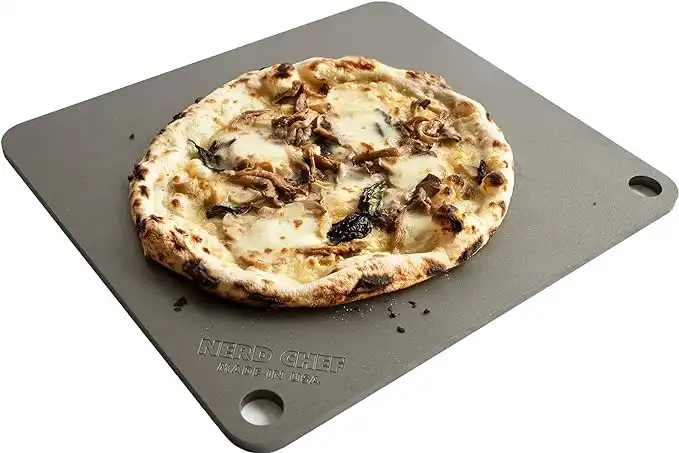 NerdChef Steel Stone
NerdChef Steel Stone
Making great crusts traditionally requires a 700-1000F wood-fired oven. Nerdchef Steel Stone replicates that performance in a home oven with its super-high heat transfer ability - transferring heat energy 20 times faster than ceramic. It creates beautiful and crispier crusts, gorgeous blistering throughout, and it cooks faster.
The Chef's flour is a general-purpose, high gluten flour that works well for many recipes. "Tipo 00" refers to how refined the flour is. Chef's Flour is best for those who want to bake in their traditional home oven up to 500 degrees Fahrenheit!
Enjoy!
Not a PRO? Not a Problem!
Take a pizza class to bring your pizza skills to the next level,
so you can be a PRO!
Related Posts

Costco Pizza Delivery: Find How You Can Get It Now!
the PROs
People go to Costco’s food court for many different reasons, but the cheesy slice of pizza they serve is among …

Pizza for Beginners: Don’t Buy Pizza, Make It! Here’s How to Get Started!
the PROs
You have this idea that you want to make pizza at home as opposed to ordering it, but where do you start? Don’t worry! Here you will find answers and directions to all your questions.

Pizza Toppings Under Cheese or Over Cheese? [Why the Order Matters]
the PROs
Is Pizza Cheese on Top or Bottom? Hey pizza lovers, are you wondering if you should layer pizza toppings under …
Newsletter
Subscribe to our Recipe of the Week newsletter and receive our partners’ latest recipes, tips, and discount offers.
Keep in Touch!
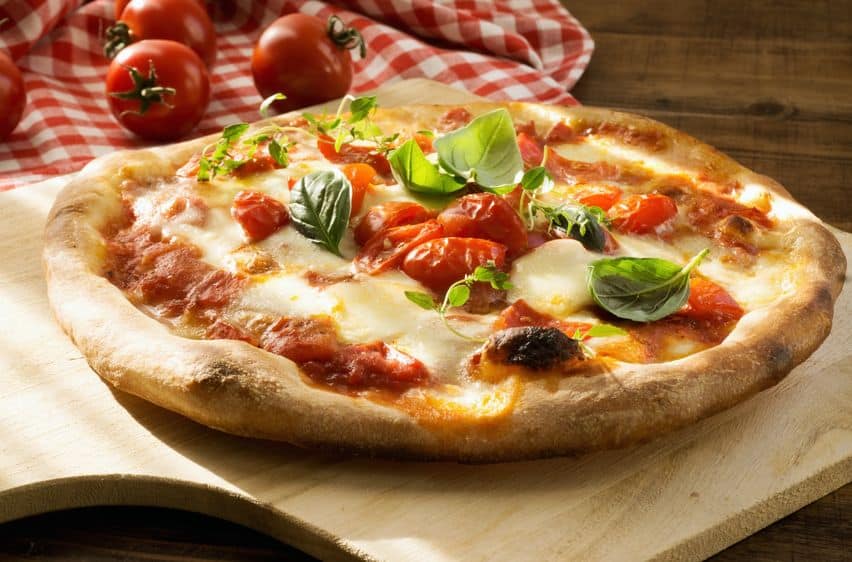

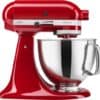
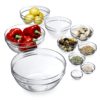
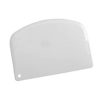
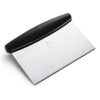
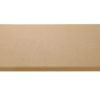
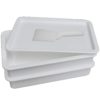
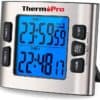






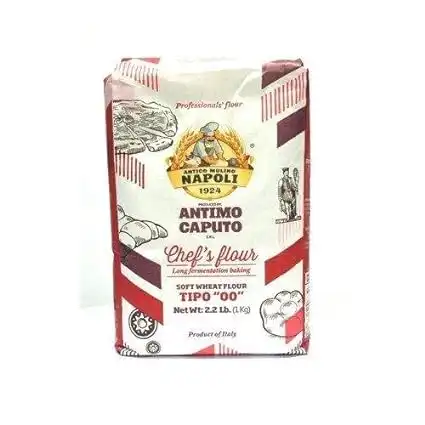

wow so amazing! the most authentic NEAPOLITAN pizza i have ever tasted, the recipe is fantastic, the instructions were simple and easy to follow. i absolutely adore this recipe!!